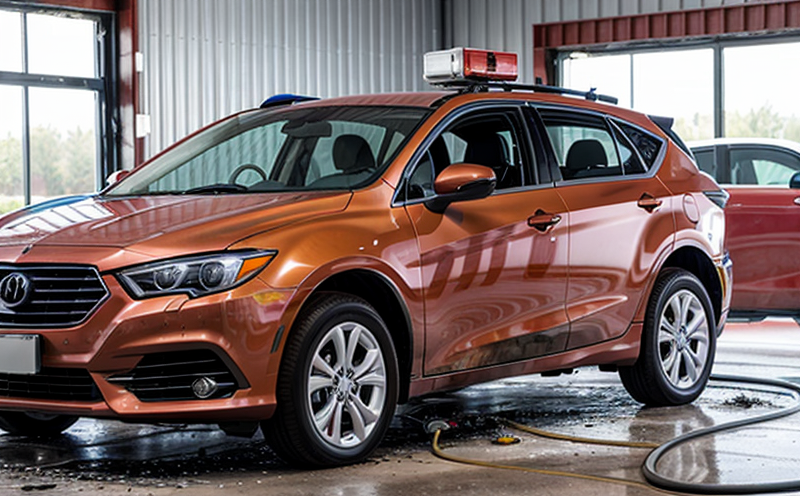Flammability Testing of Automotive Wiring Harnesses
The automotive industry is highly regulated when it comes to fire safety. Flammability testing of automotive wiring harnesses ensures that critical components do not ignite or contribute to the spread of flames under specified conditions, thereby protecting lives and preventing fires in vehicles.
Automotive wiring harnesses are complex assemblies of wires, connectors, and terminals designed to transmit electrical signals across various parts of a vehicle. These components must withstand harsh environmental conditions while maintaining optimal performance. Flammability testing evaluates the materials used in these harnesses for their resistance to ignition and burning behavior.
Flammability tests are conducted according to internationally recognized standards such as ISO 7637-2, which specifies test methods for electromagnetic compatibility (EMC) of road vehicles. This standard includes procedures that assess the ability of wiring harnesses to withstand electrical overstress without catching fire or causing significant damage.
In addition to EMC testing, specific flammability tests like those outlined in UL 94 and IEC 61508 are used to evaluate materials for their flame retardancy. These tests classify plastics based on their performance when exposed to flames. For instance, UL 94 categorizes materials into different grades (V-0 through V-2) depending on the maximum burn rate.
For automotive wiring harnesses, the test involves placing a specimen in a specially designed oven where it is subjected to controlled heating and exposure to flame. The duration of exposure varies based on the specific standard being followed but typically lasts several minutes. Afterward, the sample is examined for signs of damage or deformation.
The results from these tests help manufacturers ensure compliance with various regulations such as FMVSS (Federal Motor Vehicle Safety Standards) in North America and ECE R10 in Europe. Compliance ensures that vehicles meet safety requirements set by government agencies and reduce the risk of fires caused by faulty wiring harnesses.
During specimen preparation, care must be taken to ensure that each part of the harness is representative of its intended use within the vehicle. This may involve cutting sections from longer harness assemblies or using pre-manufactured samples provided by suppliers. Proper labeling and documentation are essential to maintain traceability throughout the testing process.
The choice of test equipment plays a crucial role in obtaining accurate results. Instruments used include specialized ovens capable of maintaining precise temperatures, flame sources designed to simulate real-world conditions, and observation windows for monitoring specimens during tests. Automation features allow continuous data collection without manual intervention, ensuring consistent and reliable outcomes.
After completing the test, analysts review all collected data points to determine whether the harness meets specified criteria regarding flame propagation rates, smoke generation, heat release rates, and other relevant parameters. Reports detailing these findings are generated for internal use or submission to regulatory bodies as part of ongoing quality assurance efforts.
Why It Matters
Flammability testing is critical in the automotive industry because it helps prevent potential hazards associated with faulty wiring harnesses. When a wiring harness fails, it can lead to short circuits that ignite nearby materials or even start fires inside the vehicle. Such incidents pose serious risks not only to passengers but also to first responders involved in rescue operations.
- Reduces Fire Risks: By identifying and addressing issues early on, manufacturers can significantly lower the likelihood of accidents caused by electrical malfunctions leading to fires.
- Promotes Safety Standards: Meeting stringent flammability requirements ensures that vehicles comply with local laws and international standards, enhancing overall road safety.
- Enhances Reputation: Demonstrating commitment to safety through rigorous testing builds trust among consumers who value peace of mind when purchasing new vehicles.
Benefits
The benefits of conducting flammability tests on automotive wiring harnesses extend beyond mere compliance; they offer tangible advantages that contribute to both product quality and customer satisfaction:
- Improved Product Reliability: Testing helps identify weak points in design or manufacturing processes, allowing for timely corrections before widespread deployment.
- Cost Savings: Early detection of defects through testing reduces the need for costly recalls later on, saving both time and money.
- Increased Market Share: A reputation for producing safe products can attract more customers, boosting sales and market penetration.
In addition to these commercial benefits, flammability testing also contributes positively towards environmental sustainability by minimizing waste generated from non-compliant products that might end up in landfills after being scrapped due to safety concerns.
International Acceptance and Recognition
- FMVSS: The United States mandates stringent fire protection requirements under FMVSS, ensuring that all passenger cars sold within the country must pass rigorous flammability tests.
- ECE R10: Vehicles intended for sale in European markets must adhere to ECE R10 standards, which include comprehensive flammability assessments among other safety measures.
- UN Regulation 46: This regulation covers fire protection requirements applicable globally, further emphasizing the importance of thorough testing across different regions.





